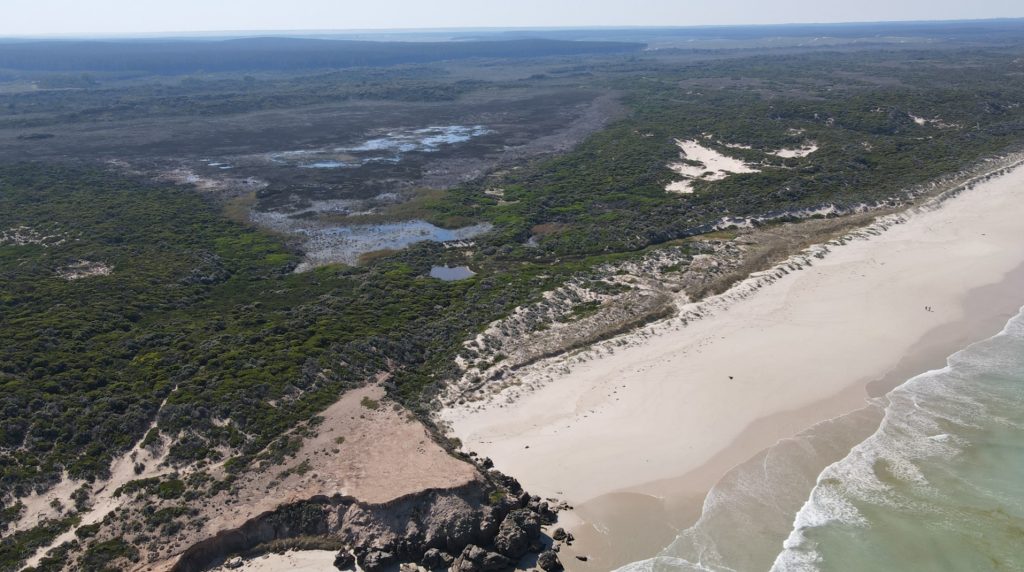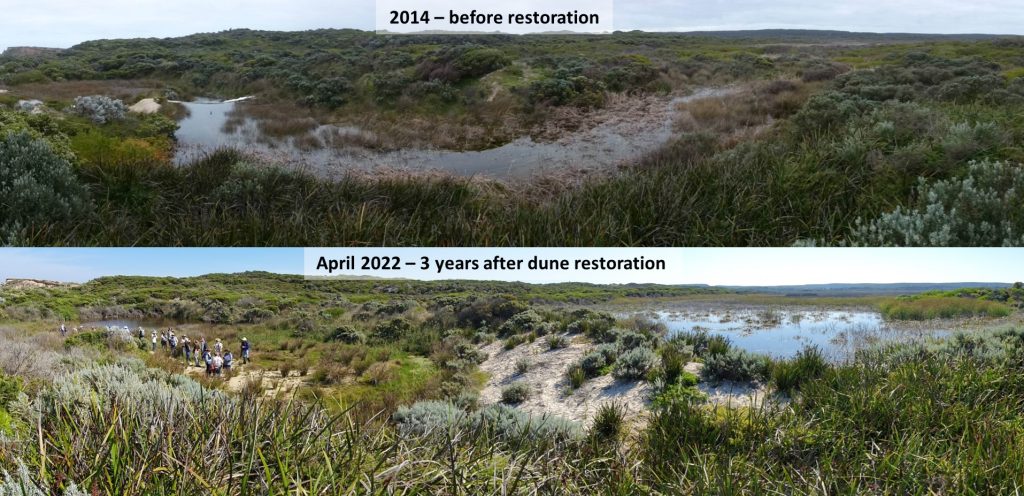The ‘end of the beginning’ of the Long Swamp restoration story
It has been one of our longest running projects – delivered by NGT over the years in partnership with local community groups (led by Nelson Coastcare), NGT volunteers, Traditional Owners, Parks Victoria, the Glenelg Hopkins CMA and DELWP – but now that our latest grant-funded project has come to an end, it marks the ‘end of the beginning’ of the Long Swamp restoration story. Long Swamp is an internationally important (Ramsar designated) wetland situated in Discovery Bay Coastal Park, between Nelson and Portland in far south-west Victoria.

To revisit the journey of this site over the past ten years, please feel free to look over past stories on our website (by clicking here).
If you take the time to do so, you’ll see that what began as small investigation back in 2012/13, eventually evolved first into a restoration trial (in 2014/15) and later permanent restoration of the sand dune (in 2019), which has seen the nearby foredunes reform and helped to reverse the long-term drying trend within Long Swamp to improve the aquatic ecological values of the site.
Over the years, we’ve talked a lot about the history of the site, including how the drain was cut to the sea in the 1930s, and we’ve also undertaken a significant amount of hydrological and ecological monitoring within the wetland, including publishing a detailed study on the response of native freshwater fish to the work.
Along the way, we experienced the exhilaration of meeting Robbie the Bittern, one of the first Australasian Bitterns to ever be satellite tracked, who chose our restoration site as his new home only a short time after leaving the Riverina region of NSW back in 2015. Robbie was our very own national ambassador for wetland restoration!
In 2018, the project was even recognised with a national award for excellence in ecological restoration, by the Society of Ecological Restoration Australasia. Around the same time, the wetland was designated a wetland of International Importance under the Ramsar Convention on Wetlands by the Victorian and Australian Governments, which was a great moment for NGT and the local community.
And this is just the tip of the iceberg!
The key location throughout was the site of restoration works in the dunes near Nobles Rocks, where the community helped us to construct the 7000+ geofabric sandbag structure back in 2015, from scratch, by hand – noting that we may never tackle another one quite this big! We did so out of respect for the cultural heritage of this sensitive stretch of coast, which was home to First Nations people (near the boundary between the Gunditjmara and Boandik people) for many millennia and is littered with past evidence of their continuous occupation and stewardship. The changing view of the main restoration site in the dunes from 2014 – 2022 is shown below, and can be viewed by clicking through the pages of the pdf.
As you will notice above, we are now starting to see the vegetation rapidly reclaim the dunes and the general location of the works themselves, and upstream of the works, the wetland habitat of Long Swamp has now well and truly settled into its new hydrological regime. This includes restoring all surface flows back along their original route, via Eel Creek and Oxbow Lake, to the Glenelg River estuary 11 kilometres downstream – reinvigorating the wetlands of Long Swamp along the way.
This is just the beginning however of the next chapter for this magnificent wetland system, as its ecology continues to recover and evolve in response the the restored water regime. Now that we move out of the active restoration works phase, subject to funding, we hope to continue to monitor and explore those hydrological and ecological changes over the years ahead.
Documenting the recovery of wetlands after restoration is incredibly important for highlighting the value of restoring natural wetlands, so that we can repeat the process elsewhere and trigger the recovery potential of these incredibly dynamic and forgiving ecosystems. You can directly support our wetland restoration work by visiting our donations page.

Nature Glenelg Trust would not have been able to tackle the restoration of Long Swamp if not for the support of so many different people, groups and organisations over the past 10 years. This final phase of the Long Swamp restoration project has been supported by the Victorian Government’s Biodiversity Response Planning (BRP) program, but we’d like to close this chapter of the story by recognising all of our partners from over the years below.

thanks the following groups and organisations for their support over the past decade at Long Swamp:

